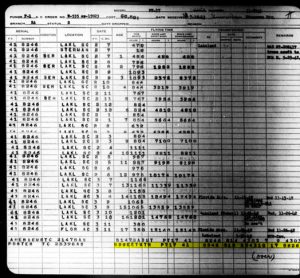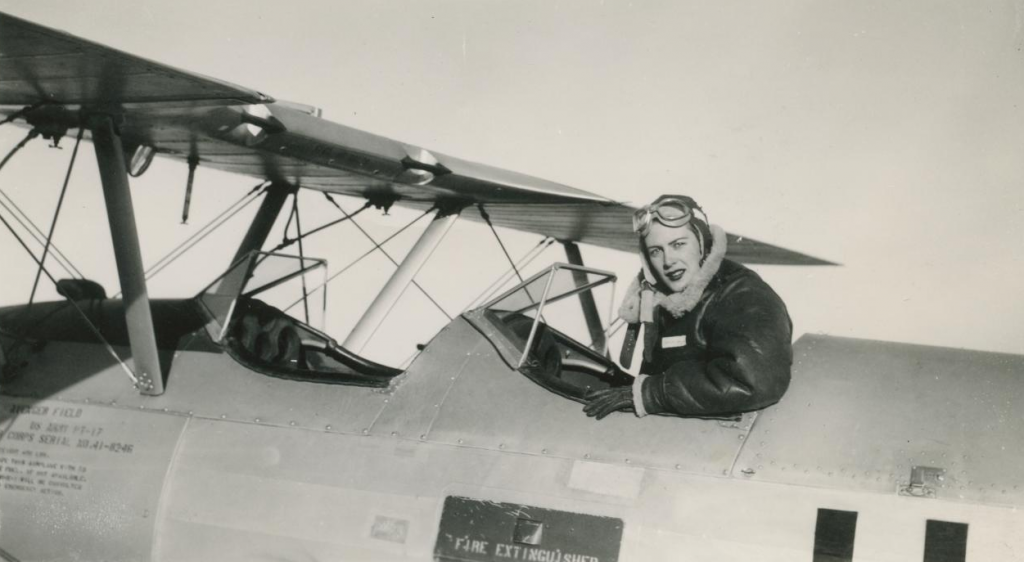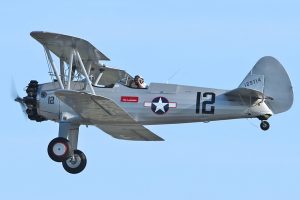The American Heritage Museum in Hudson, MA is proud to announce the discovery of a Boeing PT-17 Stearman, c/n 75-1805, USAAF s/n 41-8246 , which has a documented history as a trainer for the Women Airforce Service Pilots (WASP) at Avenger Field, TX during World War II. This historic aircraft will undergo a meticulous restoration to flying condition. Once restored, the Stearman will be a centerpiece in a new, impactful exhibit dedicated to the WASP and their vital contributions to the war effort.
The WASP were pioneering women who broke gender barriers as the first females to fly U.S. military aircraft. The PT-17 Stearman was one of the key primary trainers for these courageous pilots, helping them develop the skills necessary to fly a variety of fighters, bombers, cargo aircraft, and other types during the war in non-combat roles. This aircraft represents not only an important piece of aviation history but also the broader story of women’s empowerment and their essential role in achieving victory during World War II.
The discovery of an actual Stearman specifically used for training WASP is extraordinarily rare. With this restoration project, there are only a few examples in existence, with just two restored in their accurate WASP livery and wartime condition. This will be the sole accurately restored example on flying display within a public museum.
It is critically important to preserve and share this significant chapter of history. The PT-17 Stearman’s restoration and inclusion in the American Heritage Museum’s future WASP exhibit will ensure that the contributions of these remarkable women are recognized and remembered for generations to come, while also inspiring future generations.
The Women Airforce Service Pilots (WASP)
The Women Airforce Service Pilots (WASP) were a trailblazing group of female aviators who made significant contributions to the Allied victory in World War II. Formed in 1943, the WASP were one of the first organized groups to employ women to fly U.S. military aircraft, taking on critical roles that freed up male pilots for combat missions. These women, although civilians, were tasked with state-side military flight duties, which included ferrying aircraft from factories to military bases, towing targets for live anti-aircraft gun practice, transporting cargo, and testing repaired aircraft. Over the course of their service, WASP flew over 60 million miles in a wide range of aircraft, including fighters, bombers, and transport planes, demonstrating unparalleled skill and dedication.
The importance of the WASP goes beyond their operational contributions. They broke significant gender barriers in a male-dominated field, proving that women could perform demanding and dangerous tasks with the same proficiency as men. At a time when societal norms restricted women to traditional domestic roles, the WASPs challenged these conventions, paving the way for future generations of women in aviation and the military.
Despite their vital contributions, the WASP faced numerous challenges and were not afforded the recognition they deserved. They were paid less than their male counterparts and did not receive military benefits. Tragically, 38 WASP lost their lives in service, yet their families were not entitled to military honors or assistance. When the WASP program was disbanded in December 1944, the women were sent home, and their contributions were largely forgotten for decades. It wasn’t until 1977, after a long struggle for recognition, that the WASP were granted military status. In 2009, they were awarded the Congressional Gold Medal, acknowledging their pioneering role in U.S. military history. Congress also passed legislation in 2016 permitting WASP to be buried in Arlington National Cemetery.
Why This Aircraft is Important
Given the WASPs’ significant contributions to the nation and their role in advancing women’s rights, it is essential that institutions like the American Heritage Museum preserve and showcase their history. Developing an exhibit dedicated to the WASPs would not only honor these courageous women, but also educate and inspire the public about their critical role in World War II and the broader fight for gender equality.
An exhibit featuring an original and flyable Boeing PT-17 Stearman, with documented history as a trainer for the WASP, would be particularly impactful. With most WASP now gone, this aircraft is one of the last direct witnesses to their dedication to duty and sacrifice. There is memory in the metal, wood, and fabric of the aircraft. Displaying this aircraft in a dedicated exhibit, along with personal stories, photographs, uniforms, and other artifacts, would provide visitors with a tangible connection to the WASPs’ experiences. It would help convey the challenges they faced, the skills they developed, and the barriers they broke.
Maintaining the Stearman as a flyable artifact would allow us to keep this important part of history alive as a teaching tool for our future generations. Imagine the impact of witnessing a female pilot fly the Stearman as part of our aviation history weekends and the potential inspiration it would generate in young women as they navigate a future in the armed forces, aviation, engineering, technology, or other groundbreaking careers.
And finally, such an exhibit would serve as a powerful reminder of the often-overlooked contributions of women in wartime. It would highlight the importance of recognizing and preserving the stories of Americans who have continually worked to advance equal opportunity. By showcasing the WASP and their legacy, the American Heritage Museum would be contributing to a broader understanding of World War II and the diverse individuals who played a role in its successful outcome.
The Project
 Rolling off the production line in 1942, Boeing PT-17 Stearman Kaydet construction number 75-1805 was taken on strength in the same year under US Army Air Force serial number 41-8246. Originally assigned to Training Command in Lakeland, FL, it was transferred in late 1943 to Avenger Army Air Field in Sweetwater, Texas (highlighted at right). This location was home to 318th Army Air Forces Flying Training Detachment, 31st Flying Training Wing, which was tasked with training the newly formed Women Airforce Service Pilots (WASP). In short order, Avenger Army Airfield became an all-female installation except for a few male instructors and other officers.
Rolling off the production line in 1942, Boeing PT-17 Stearman Kaydet construction number 75-1805 was taken on strength in the same year under US Army Air Force serial number 41-8246. Originally assigned to Training Command in Lakeland, FL, it was transferred in late 1943 to Avenger Army Air Field in Sweetwater, Texas (highlighted at right). This location was home to 318th Army Air Forces Flying Training Detachment, 31st Flying Training Wing, which was tasked with training the newly formed Women Airforce Service Pilots (WASP). In short order, Avenger Army Airfield became an all-female installation except for a few male instructors and other officers.
Classes entered the WASP program in monthly intervals. A total of 18 classes completed training: 8 in 1943 and 10 in 1944. Of the 25,000 women who applied for flight training, 1,830 were accepted, and of those, 1,074 received their wings.
The PT-17, as a Primary Trainer, was the first aircraft that a WASP trainee would fly and be expected to master. In this role, Stearman 41-8246 was used heavily. The first four month course required pilots to accumulate 115 hours of flight time – later extended at the end of 1943 to 210 hours over 27 weeks.
An identifiable photo of 41-8246 in WASP training service resides in the University of North Texas archive. The image also features WASP Edna Davis, a member of class 43-5. Since she was a child, she always dreamed of learning to fly. She realized this goal thanks to her training at Avenger and went onto fly a wide variety of military types and holds the distinction of the first WASP to fly the B-26 Marauder medium bomber.

The aircraft remained at Avenger Field until December 1944 when the WASP were disbanded. The aircraft was considered surplus after WWII and sold for civilian use by the War Assets Administration. It passed through several hands as a crop duster and was later configured for sport use with a number of modifications, including custom fiberglass side panels, a rear cockpit fairing, and a more powerful radial engine – all a departure from its original factory configuration.
The aircraft was offered as a project for sale in 2023. The American Heritage Museum, with the help of noted and award-winning Stearman restoration expert Mike Porter, discovered its WASP provenance. With this knowledge in hand and committed to the goal of restoring the Stearman back to its Avenger Field status, the American Heritage Museum purchased the project. It is now with Mike Porter awaiting a full rebuild.
Mike has restored over 20 Stearman aircraft over the years and is a singular resource within the historic aircraft community. His restorations have won Golden and Silver Wrench awards at the annual EAA AirVenture Oshkosh airshows as well as notable awards at the National Stearman Fly-In in Galesburg, IL. He understands both the mechanical and historic elements of the Stearman second to none.
 One of Mike’s most famous and rewarding Stearman restorations is his family’s award-winning 41-25714, a sister PT-17 with WASP history. Finished in 2012, Mike spent over five years restoring the aircraft to exacting standards and breathtaking accuracy. It appears exactly as it would have at Avenger Field in 1943. As part of this journey, Mike got to know many of the WASPs. Preserving their heritage means a great deal to him. Because of his experience with this aircraft and his leadership role in the broader Stearman community, it was a natural decision to choose Mike as the restoration specialist to bring 41-8246 back to its original airworthy configuration.
One of Mike’s most famous and rewarding Stearman restorations is his family’s award-winning 41-25714, a sister PT-17 with WASP history. Finished in 2012, Mike spent over five years restoring the aircraft to exacting standards and breathtaking accuracy. It appears exactly as it would have at Avenger Field in 1943. As part of this journey, Mike got to know many of the WASPs. Preserving their heritage means a great deal to him. Because of his experience with this aircraft and his leadership role in the broader Stearman community, it was a natural decision to choose Mike as the restoration specialist to bring 41-8246 back to its original airworthy configuration.
The restoration of 41-8246 will begin with the overhaul of an original 220 hp Continental R-670 radial engine. Next will be the rebuild of the wings, eliminating any post-WWII modifications and returning them to factory-fresh condition. A similar treatment to the fuselage will be required as a number of modifications were made through the years. The intention is to restore the aircraft to the exact configuration it would have had in 1943.
Once finished and returned to airworthy standards, the Stearman will be flown to the American Heritage Museum to become part of a permanent public gallery highlighting the history of the WASP and their impact on the role of women in aviation and technology over the past 80 years and beyond. It will continue to take to the sky as part of our living history exhibitions to honor the WASP, educate the public about their service, and inspire future generations.







